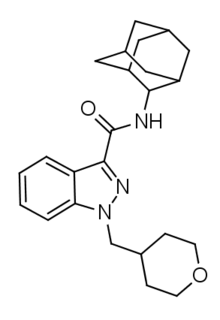Adamantyl-THPINACA
 | |
| Legal status | |
|---|---|
| Legal status |
|
| Identifiers | |
| |
| CAS Number | |
| Chemical and physical data | |
| Formula | C24H31N3O2 |
| Molar mass | 393.53 g/mol |
| 3D model (JSmol) | |
| |
| |
Adamantyl-THPINACA (ATHPINACA, AD-THPINACA)[1] is an indazole-based synthetic cannabinoid,[2] which was first reported to Europol in Slovenia in January 2015.[3] It is known as both the 1-adamantyl and 2-adamantyl isomers (SGT-40 and SGT-194 respectively), which can be distinguished by GC-EI-MS.[4] It is banned in Sweden.[5] and Russia[6]. Both the 1-adamantyl and 2-adamantyl isomers are specifically listed as illegal drugs in Japan.[7]
See also
References
- ↑ "ATHPINACA isomer 1 (CAS 1400742-48-4)". Caymen Chemical. Retrieved 29 April 2017.
- ↑ "Muuntohuumeiden esiintyvyys 2015" (PDF). Finnish Medicines Agency. 7 May 2015. Retrieved 24 July 2015.
- ↑ Europol 2015 Annual Report on the implementation of Council Decision 2005/387/JHA
- ↑ Asada A, Doi T, Tagami T, Takeda A, Sawabe Y (March 2017). "Isomeric discrimination of synthetic cannabinoids by GC-EI-MS: 1-adamantyl and 2-adamantyl isomers of N-adamantyl carboxamides". Drug Testing and Analysis. 9 (3): 378–388. doi:10.1002/dta.2124. PMID 27770510.
- ↑ "Fler ämnen föreslås bli klassade som narkotika eller hälsofarlig vara". Folkhälsomyndigheten. Retrieved 24 July 2015.
- ↑ http://www.consultant.ru/cons/cgi/online.cgi?req=doc&base=LAW&n=222059&fld=134&dst=100034,0 List of substances prohibited in the Russian Federation
- ↑
This article is issued from
Wikipedia.
The text is licensed under Creative Commons - Attribution - Sharealike.
Additional terms may apply for the media files.